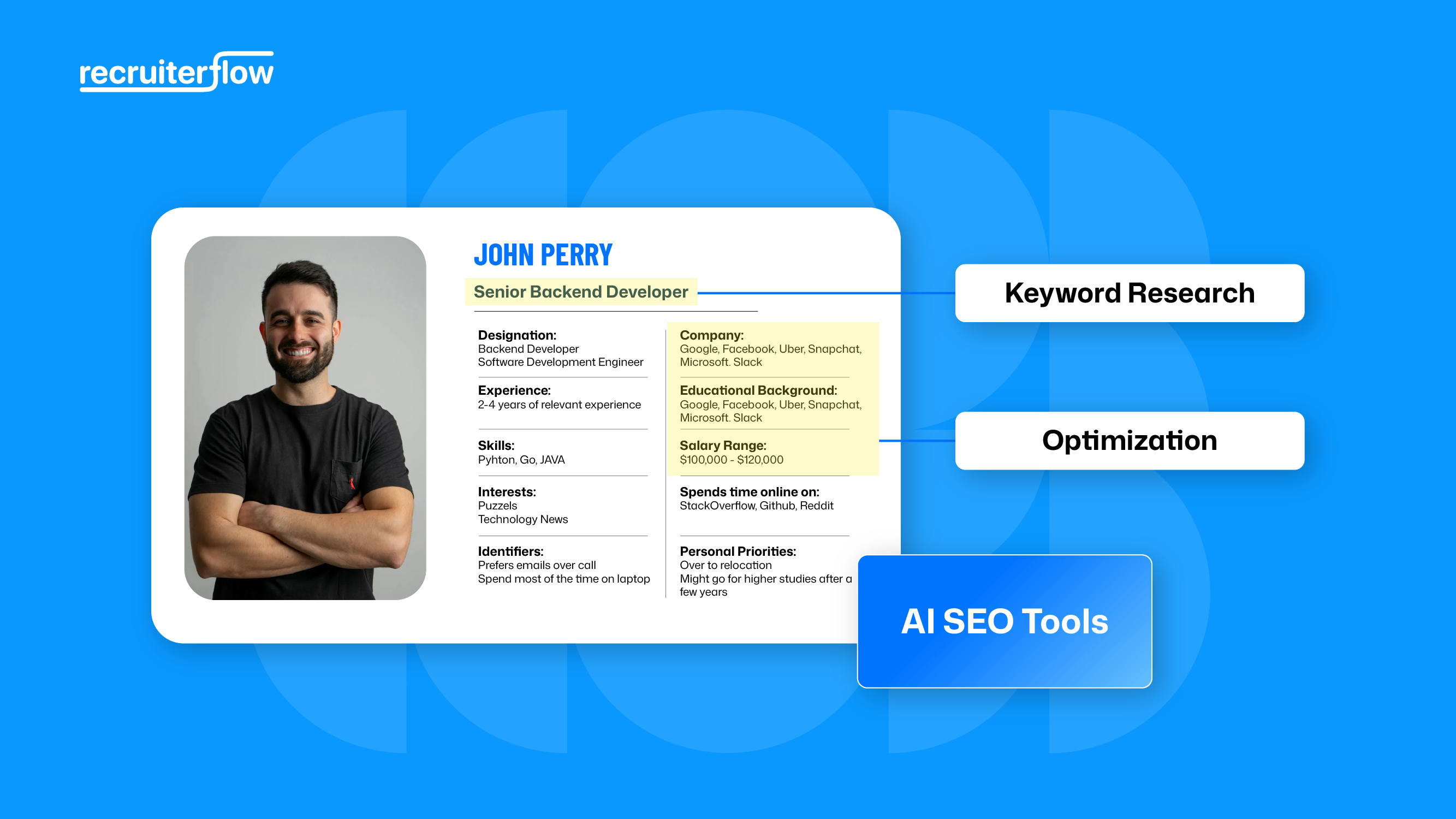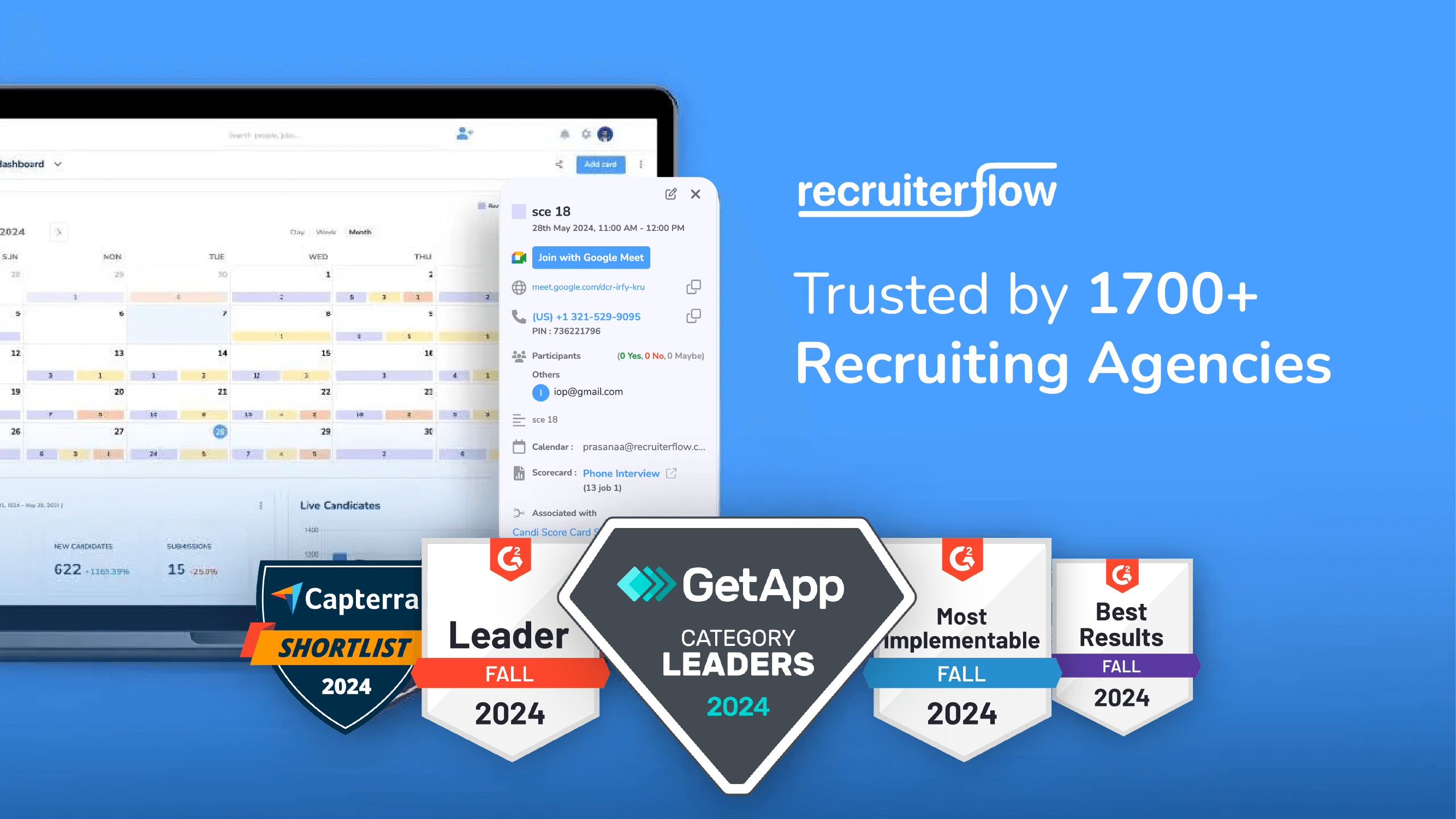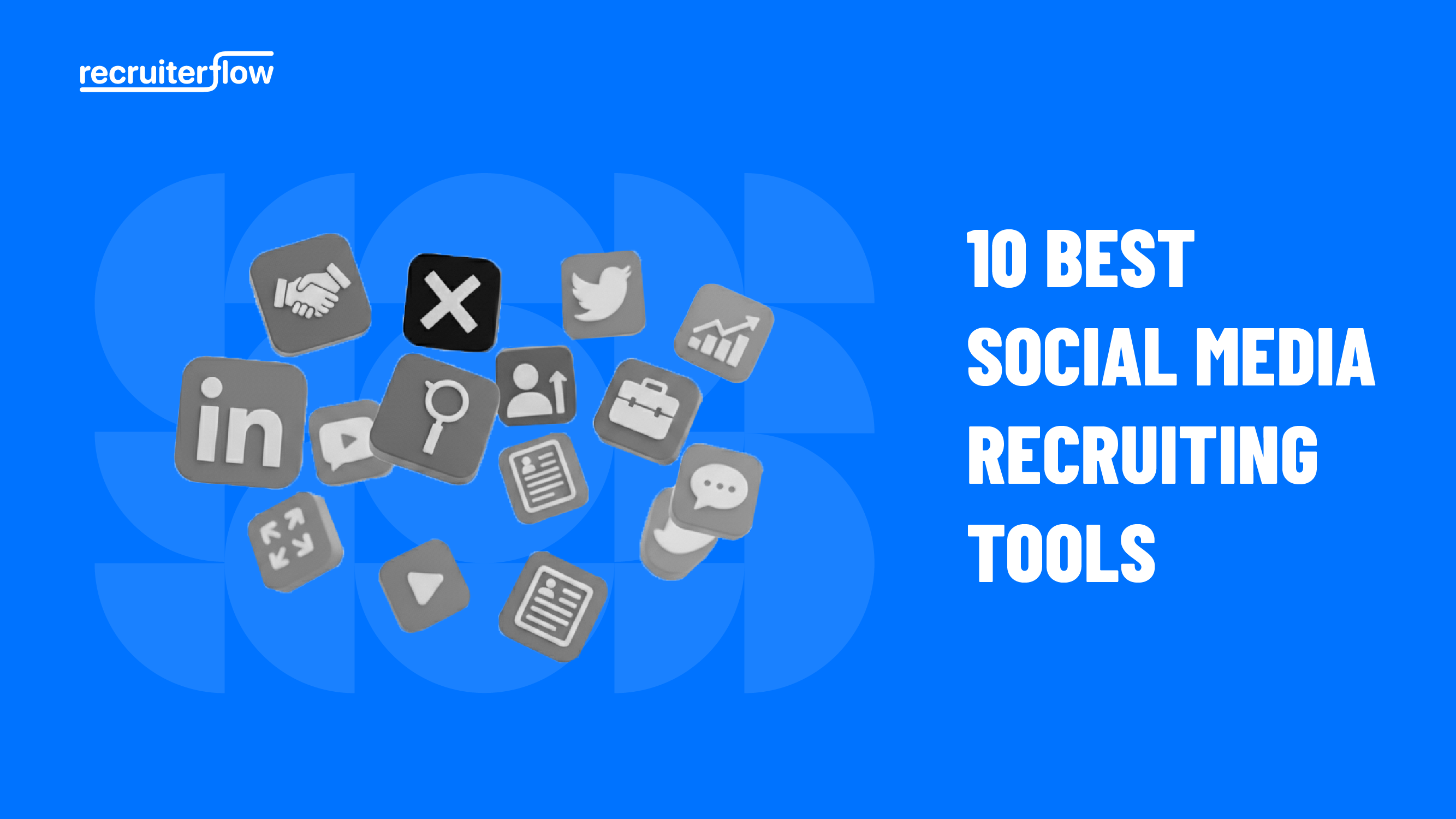
Ultimate Guide to SEO for Recruitment Agencies

Your ability to hire top talent in 2025 depends on more than just having a strong network or solid connections in your industry. It now relies on how well your job postings rank on search engines.
Since 79% of job hunters use online resources to find jobs and 73% of searches for jobs begin on Google, knowing how to optimize job postings for SEO is crucial to compete in modern recruitment.
It helps increase visibility and turn your agency into a talent hub that draws skilled candidates while making you the trusted recruitment partner in your field.
If you’re a small agency trying to outshine bigger companies or a well-known firm aiming to expand online, this guide’s SEO strategies can help you get ahead.
In this guide, we will define and understand the importance of SEO for recruitment agencies, the role of SEO in job posting, and the best SEO strategies.
What is Recruitment SEO?
SEO is the practice of ranking your website on search engine results pages like Google and Bing. It drives traffic to websites. Recruitment SEO is the practice of creating a strategy that focuses on the ways people search for jobs and career opportunities.
Recruitment SEO uses strategies to improve job postings, career pages, and hiring-related content so they appear higher in search results when candidates look for jobs.
It centers on figuring out how your target candidates search for jobs and tailoring your content to fit those habits. This approach goes past just using keywords and works on building useful, detailed content that supports every stage of a job seeker’s search.
The main idea is straightforward and effective. If someone looks up “marketing manager jobs in Chicago” or “remote software developer positions,” your well-optimized job listings should show up high in the search results.
Recruitment SEO, though, isn’t just about individual job ads. It also shapes everything in your online hiring presence, like career pages, content about your company’s culture, or resources tailored to specific industries.
Modern recruitment SEO includes technical parts such as adding structured data markup to assist Google for Jobs, making sites that are mobile-friendly, and optimizing for voice search since 28% of people report daily use of voice assistants.
Google’s AI tools like RankBrain and BERT now better grasp what users are looking for, meaning recruitment content that helps candidates will rank higher and attract better traffic.
Why Does SEO Matter to Recruitment Agencies?
Recruitment agencies battle over similar talent pools with identical job openings and qualifications. SEO is one of the key pillars of recruitment marketing for agencies to find candidates, attract clients, and strengthen their market presence over time.
The financial effect is huge. Agencies dealing with staff shortages or frequent turnover often spend hundreds of thousands each year on old-school methods like job board ads.
SEO offers a cheaper option with lasting benefits. Paid ads work while you keep spending, but strong SEO content keeps drawing candidates long after it’s published.
Attracting clients comes with big advantages. When your agency shows up in search results related to recruitment topics, it does more than draw in candidates.
It builds trust and authority that pulls in potential clients, too. Around 23.1% of recruiters use content to connect with candidates and highlight company culture, but those who gear this content toward search engines get far better outcomes.
Searches including “near me” have surged in recent years. This means smaller agencies can compete with the big players by using local SEO to target specific markets.
Moreover, SEO turns passive hiring efforts into active candidate engagement, attracting qualified job seekers looking for roles and removing the need to chase after candidates.
This change from pushing to attracting candidates reshapes recruitment costs and helps agencies expand while finding better talent.
Why Job Posting SEO Is Crucial Today
The hiring world has changed a lot. A single listing on one platform no longer attracts hundreds of skilled applicants. Modern job seekers use search engines to explore openings just like they would when shopping for something important.
The numbers reveal something important. Over half of job seekers, about 50%, prefer using search engines like Google to search for job openings.
What’s even more striking is that candidates from Google for Jobs are four times as likely to apply compared to those who come through regular organic search. Agencies that skip optimizing for search are invisible to most of the talent out there today.
When your job listings rank high in relevant searches, you reach people who are already seeking what you offer. This means stronger job applications and better results in placements.
The competition in this field has grown a lot. Since 65% of recruiters rely on social media platforms to find talent, the digital hiring space is now overcrowded. Companies that use smart SEO techniques are getting noticed AND gaining advantages that keep growing more valuable as time goes on.
Key Methods to Boost Job Posting SEO
Keyword Research Strategy
Keyword research lays the groundwork for recruitment SEO.
Start by building candidate profiles. Focus on creating detailed candidate personas. Include information like where they are in their careers, what industry they’re part of, location preferences, demographics etc.
Focus on using search terms tied to specific industries. AI tools can find long-tail keywords like “junior software engineer remote job,” which see fewer searches but bring in candidates with precise goals and needs.
Incorporate strategies that use location-based keywords. Many job seekers search with their location included, such as “nursing jobs in Phoenix.” Creating lists of keywords that mix roles, skills, and locations can help attract local search traffic that matters.
To find new keywords, analyze your competitors, direct or otherwise. Tools like SEMrush, Ahrefs, and Google Keyword Planner can show keywords your competitors rank for. This helps you spot overlooked options and understand how strong the competition is for valuable keywords.
Optimizing Job Postings for Better Page Rankings
Optimizing on-page elements turns basic job ads into tools that draw job seekers to your site. These strategies also give users a smoother experience. The main on-page elements that affect rankings include the meta tags, URL, and the page content.
Optimize meta titles to boost click-through rates. You should include the company name and job title in a catchy tagline no longer than 70 characters. For instance, “TechCorp – Senior Marketing Manager – Remote” shows the job, work setup, and employer while aligning with Google’s preferred title lengths.
Crafting a descriptive, keyword-focused URL structure helps as well. To highlight the job specifics, use a URL like “www.jobs.company.com/java-developer-phoenix-arizona.” This kind of URL gives clear information to search engines and job seekers about the page details.
Write body content that answers candidates’ needs. Aim for about 500 words where you highlight the position, industry, and location. Do not overuse keywords. Focus instead on creating helpful content that discusses the job, the workplace culture, chances for career growth, and how to apply.
Use smart internal linking. Link job postings to company pages, career tools, and similar roles. Doing so helps search engines to see how your site is organized while giving job seekers more useful details about your company and open roles.
Improve visibility in featured snippets and voice search. Arrange content using clear headers, lists, and FAQs so it’s easy to pull into featured snippets. Featured snippets matter a lot to voice search because they give quick answers for virtual assistants.
Pro tip: Create branded career pages by using Recruiterflow so your listings get indexed on search engines. The no-code career page builder makes it easy for anyone to set up career pages in seconds, with no technical knowledge required.
Optimize Content for Voice Searches
More job seekers now rely on conversational voice searches to discover job opportunities, which makes voice search optimization vital.
You should prioritize long-tail keywords designed for natural conversation. For instance, when job seekers use voice search, they might ask things like “What are the best remote marketing jobs available now?” instead of typing “remote marketing jobs.”
Provide clear and direct answers. The opening sentence should define the topic. Use the next couple of sentences to share 2-3 key facts people need to know about it. This method works best when describing job roles or writing job descriptions, especially when using various sentences to clearly explain responsibilities, tasks, and expectations.
Use patterns from local voice searches. Many voice search queries show a focus on nearby services or locations, like “IT jobs in Chicago” or “digital marketing roles close to me.” Write content with casual location-based phrases so search engines can pick it up for these types of voice queries.
How Recruitment Agencies Can Use Local SEO
Local SEO gives recruitment agencies big chances to lead their area markets and reach nearby talent and employers who need regional knowledge. Employers look for people within a specific travel range due to things like commuting or local company rules.
Recruitment agencies need to optimize their Google Business Profile. Managing Google Business Profiles, including reviews, photos, Q&A sections, and showing up in local searches, helps in staying visible.
Try to add as much information as you can, including detailed descriptions about services, specialties, and contact details. Ratings and reviews also influence the decision. So, ask satisfied clients and job-seekers to post reviews.
Create strategies focused on specific locations. Use location-based keywords in your writing to help readers and search engines understand your content. Share reports about job markets in particular cities, salary insights, or industry trends to show your know-how in local areas.
Creating landing pages for neighborhoods and industries is equally helpful. A web page that focuses on specific areas and industry niches, like “Healthcare Hiring in Downtown Chicago” or “Tech Jobs Around Austin’s Domain”, is more likely to rank compared to a generic landing page.
Also read: 12 Best Job Posting Sites for Recruiters in US & UK [Free + Paid]
AI SEO Tools for Recruitment Agencies
AI-powered SEO tools and automation let recruiters find the right candidates quicker and with more accuracy.
Many agencies now use ChatGPT for SEO to research keywords, improve content, and track performance. Keep human input involved to ensure the content reflects your brand and fits what candidates need.
Advanced tools like GPT-4 are getting better at creating high-quality, SEO-friendly content fast. This progress is helping agencies optimize huge volumes of job posts with ease. Having said that, we highly recommend using AI tools for content ideation and not relying entirely on AI-generated content.
Implement Generative Engine Optimization (GEO) strategies and optimization techniques. Focus on setting up schema to highlight featured snippets, FAQ sections, and voice search content. Search engines deliver more direct answers as they evolve. Using AEO positions your content where it gets noticed.
Also read: 15 Proven Recruitment Marketing Ideas in 2025
How Recruiterflow Simplifies SEO to Help You Succeed
Recruiterflow is an AI-first platform that can help recruitment agencies with SEO. Tools like branded careers pages ensure agencies are able to rank for the relevant keywords.
Recruiterflow’s AIRA is every recruiter’s AI twin. It is a suite of AI agents that helps recruiters produce more. With respect to SEO, AIRA makes it extremely easy to create job descriptions. It uses information from notes, emails, and call transcripts to create context-aware content.
AIRA also studies job-related data and provides usable insights. It spots hiring process bottlenecks and uncovers chances to work more effectively. This lets agencies figure out why some job listings show up better in search results and helps them improve SEO over time.
Recruiterflow simplifies your workflows for creating and improving content. It allows saved summaries to be reused in many areas, like when pitching a standout candidate (MPC), writing email templates, adjusting resumes, or filling out profiles in the client portal. This ability to reuse content keeps SEO-friendly summaries consistent everywhere they appear.
The platform also comes with built-in analytics that deliver detailed data on how job postings perform, how candidates interact, and what conversion rates look like. This information helps agencies tweak their SEO plans based on actual numbers instead of guesses.
Learn How Our AI-Powered Recruitment Platform Can Help Your Agency

Recruiterflow is an AI-first recruitment platform that serves as a command center for all your agency’s recruitment operations:
- AI-first screening and sourcing tools
- AI recruiting assistant
- Unified ATS & CRM
- Centralized candidate database
- Automated, multi-channel outreach (Email, SMS, Call & Socials)
- No-code recruiting automation
- Data enrichment capabilities
- Advanced reporting and analytics
- Open APIs and a host of integrations
Hudson B., CEO & Founder, reviewed us on G2Crowd:
“We’ve been using RecruiterFlow for the past two years and it has streamlined our recruiting process. The platform has a user-friendly interface and automation tools that help us efficiently manage candidate pipelines, reduce manual tasks, and communicate with clients. It serves as the command center for our recruiting operation, allowing us to focus on building relationships. They have exceptional customer success, are quick to assist, eager to hear feedback, and committed to product development. I recommend it to any agencies looking to optimize their workflows.”
See it in action now: Book a free demo
Recruitment


Pragadeesh Natarajan